Design Awards 1991 - TrustNews Winter 1992
The Awards and Commendations were announced and presented by the Mayor, Councillor Captain R J Bates RN, at The Heritage Centre on 31st January. We print below the report of the Chairman of the Selection Panel, Gordon Michell RIBA, who was consultant architect at The Civic Trust, and author of the Royal Fine Art Commission's publication 'The High Street'. He was responsible for the regeneration of the Derbyshire market town of Wirksworth, and is currently working on a similar project at Calne, Wiltshire.
"I was particularly pleased to be asked to participate in judging the entries to the Trust's Design Awards 1991. Among the many reasons for being pleased, two stood out in my mind.
First, although I have never known Winchester well I have always remembered it as being one of our most beautiful cathedral cities in spite of the damage inflicted on it since the War. Throughout the centuries succeeding generations have regarded it as important and there is an abundance of evidence of this through what they left behind. With a good guide, a walk around the city or to look down on it from the higher ground around, is like reading a good history book. To me, therefore, Winchester has always been a special place, a place which calls for the most sensitive treatment and attention, a place in which resident and visitor alike should be encouraged to feel and exercise civic pride.
Second, for many years I have enthusiastically supported ventures which help to draw peoples' attention to their environment and to the special qualities of the place. The more special these are the greater is the need for an organisation having as its main aim the creation in everyone of all ages this greater sense of civic pride. This is one of the aims of the Winchester Preservation Trust's Design Awards scheme and it calls for our wholehearted support.
The response to its fifth year since being launched in 1983 has been heartening and the number of entries - 32 - is a record which demonstrates the interest in the scheme by those who have been responsible for change and improvement within the City over the last two years. The range of these entries has also been impressive - the rebuilding of boundary walls, which are such a feature of the City scene, to new shop fronts, to new city centre redevelopment schemes, housing schemes, a new bridge, and to workshops on the industrial estate. The number of entries and their quality, to say nothing of the care taken in presenting them, made assessment a lengthy and in some cases, difficult task but from our deliberations emerged a high level of unanimity. The offering of nine Awards and seven Commendations is surely sufficient evidence of the extent to which the Selection Panel were impressed by the response this year, although the Panel had hoped for rather more entries relating to landscaping, shop fronts and environmental improvements.
The quality of design of shop fronts and their fascias is of paramount importance in retaining and enhancing the character of the City's shopping streets. Although the entry in the category to which we have offered an Award this year, Jones Bootmaker, is of a traditional design the panel did not select it on this account. It is a design which respects the building of which it is part, is well-mannered, is in scale with its surroundings and, quite clearly, fits in and is acceptable. The beautiful restoration of 33 High Street has attracted a tenant who has installed a plate-glass shop front with double glass doors, the whole topped by a simple fascia for their name and the nature of their business. It was not completed in time to be entered for a 1991 Award, but it serves to remind that ancient and modern can live happily together and that a successful shop front can be very simple and free from gimmickry. We were delighted to be able to give an Award to a piece of imaginative and unmistakably modem architecture; Devenish House for St John's Winchester Charity. Winchester, as any other historic but living city, needs to be able to boast of the best of contemporary architecture as well as cherishing its historic buildings and street scenes. All too often new development has neither the charm of the old nor the inspiration of the new; it is poor pastiche. Of this we were rather depressingly aware as we went round the City. There was, however, encouraging evidence that the charm of the old is being increasingly recognised through sympathetic restoration and rehabilitation. It is a pleasure, for instance, to admire the skilful refurbishment of No 1 Southgate Street as it stands in a prominent position at the entry to the old City.
As much a part of Winchester, these days, are of course the industrial estates, and here we found another Award winner in the new Fire Brigade Workshops, proving that the workplace can be practical as well as attractive to the eye. Low cost housing has been another success story in Winchester of recent years, and we were pleased to note some good features and imaginative lay-out in the schemes we visited.
While most entries concerned either new buildings or the rehabilitation of old ones, one becomes very aware that it is not solely the design of the buildings which concern us in maintaining the character of the place. It is the care and thought given to the spaces created by, or between, buildings which are important. They not only enhance and create the right setting for buildings but they provide sudden and often exciting variations from the regular street pattern for pedestrians; these are places where there are opportunities for some interesting landscaping, a paving pattern depicting something of the city's rich history, some seats, and - yes, why not - a work of art or craftmanship. The opportunity to provide such a space as a pleasurable contribution to the city occurs rarely - it did in the development of Walcot Place in the High Street but sadly the Panel did not feel the challenge had been taken up.
It may come as a surprise to the observant reader that the redevelopment of a large site in the centre of the High Street has failed to feature amongst the schemes recognised for their design quality or as being, at least, a good try which has not quite made the standard of an Award. The redevelopment of the former Woolworths site, submitted for an Award, gave the developers and their architects a unique opportunity to make a lasting contemporary contribution to the architectural heritage of the city's High Street. Standing in the High Street one cannot avoid being impressed by the richness of this heritage and the variety of styles but, above all, by the sheer character and interest of the buildings which line the street. The Panel tried hard and long to find any of these qualities in this development which we regard as being totally inadequate for the importance of its location. It must surely be regarded as a misleading example of the state of the art of architecture in the 1990s. Fortunately it was not representative of the entries as a whole. We considered the general level of entries to be high and hope that the increase in number will be repeated in 1993."
The 1991 Design Awards were divided into 5 categories: 1. New Buildings; 2. Rehabilitation/Restoration of old buildŽings; 3. Landscape; 4. Shopfronts, fascias and facades; 5. Environmental improvements.
The Award winning schemes are illustrated here, and the commendations are listed, with the Selection Panel's comments.
AWARD WINNERS
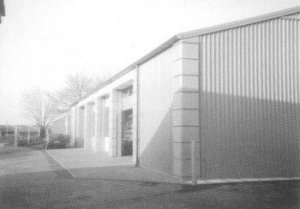

HAMPSHIRE FIRE BRIGADE WORKSHOPS
Winnall Industrial Estate
Cecil Denny Highton Architects
With good use of colour and clean proportions, the new Spray Workshop (above) and refurbished shed set high standards for industrial buildings.
DEVENISH HOUSE
Extra Care Unit for St John's Winchester Charity, Southgate Street
Plincke Leaman & Browning Limited Architects
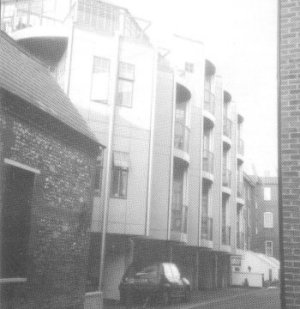
An Award is given for the new extension at the back with link to the front of the building. A thoroughly modern, imaginative design with interesting use of contemporary materials producing an enlightened outlook in a restricted site. These bow-fronted buildings at the rear reflect designs in Winchester from an earlier era. However, to ensure that such architectural solutions are to enjoy public confidence, it is essential that there is a high standard of maintenance of the materials to retain the good appearance of the building.
PIZZA EXPRESS
No 1 Bridge Street
Enzo Apicella

An Award is given for the restoration of the exterior and interior of the building, and the restraint shown in the treatment of woodwork, logo and fascia. The Panel had some doubts about the recessed entrance and adjoining window, but felt that, given the very restricted pavement space, it was an acceptable solution, although the blue plastic door handles seem inappropriate for the character of the building.
UNITED CHURCH
Jewry Street
Plincke Leaman & Browning Limited Architects
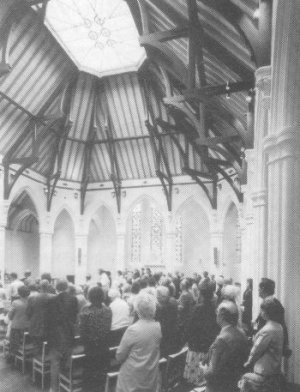
An Award is given for the refurbishment and decoration of the church interior. The skilful placing of the new floor level in relation to the existing vaulted ceiling was particularly noted. New, but most satisfying proportions are achieved.
33 HIGH STREET
(Bow fronted building on left of photograph)
Clarke Baxter Partnership

The restoration of the whole fabric inside and out has been very carefully carried out. The craftsmanship - using traditional methods - involved in the reconstruction of the medieval timber frame is particularly appreciated.
JONES BOOTMAKER
17 The Square
J 0 Gross MCSD

The Panel greatly welcomes the care taken in the design and execution of the shop front of this restored building, which fits harmoniously with its neighbours in this important city center square.
REPAIRS TO BOUNDARY WALLS
4 The Close
The Sarum Partnership Architects
Everest Construction Limited

An Award is given for repairs and rebuilding of a very important section of wall in The Close - executed with great care and attention to detail, using traditional flint-wall building techniques and associated materials.
REBUILDING OF WALL
64 Edgar Road
Scammell & Higgins Construction
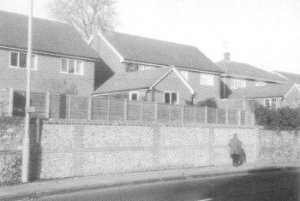
An Award is given for the rebuilding of a section of wall on St Cross Road. This displays careful attention to traditional flint-wall techniques, and has been skilfully carried out and finished.
NEW DURNGATE BRIDGE
County Architects/Surveyors and Planning Department
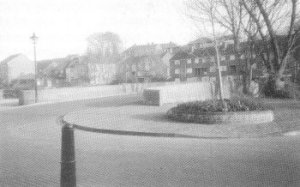

An attractive solution to a problem of a dangerous and unsightly area. It is immeasurably safer and more pleasant for pedestrians, and has greatly improved the surrounding area.
(Suggestions: a) a seat in the pedestrian area facing on to the Nature Reserve, and b) a weather/vandal resistant panel, somewhere in the pedestrian area, showing how the new bridge has improved the area with an illustration showing what had been there).
COMMENDATIONS
CHURCH CENTRE, CHRIST CHURCH
Sawyer Architects Plc
The Panel welcomes particularly the design of the ambulatory together with other aspects of the building as viewed from Christchurch Road. The ambulatory forms part of an inner court 'oasis' and is a link building between the Church and halls and offices.
UNITED CHURCH
Jewry Street
Plincke Leaman & Browning Limited Architects
The new hall at the rear of the building was thought to be a visually exciting and ingenious design solution to the problems of providing access for the disabled - marred by the fact that acoustic problems have reduced the benefits of its proposed use.
WALES STREET AND COLSON ROAD
Plincke Leaman & Browning Limited Architects
General layout of whole scheme is pleasant, particularly Colson Road. An unpretentious development of houses designed with good simple proportions. It was noted that there was not enough storage space provided, which results in the dustbins being placed permanently outside. The Panel criticised the Wales Street elevations for the appearance of steep steps and their railings, and the rather mean balconies.
16, 18, 20, 22 TOWER STREET
City Architect A L Harding
The Panel congratulates the City's action in saving this terrace which was in need of considerable underpinning. The restrained treatment of the restoration is appreciated, although the extent to which repointing was warranted was questioned.
1 ST CROSS ROAD
Williams Lester Architects
The refurbishment and adaptation of this building has been particularly successful with regard to the front elevation.
4 EASTGATE STREET
Radley House Partnership
A good piece of restoration of the parapet of No 4, thereby completing the balustrades in this terrace of houses.
"THE CONSERVATORY"
Off Station Approach, Chesil Street
GMA Landscape
The inner courtyard of this housing scheme run by the Winchester and District Housing Association, has been carefully landscaped and planted, and provides a good example of what can be achieved in a fairly constrained space.
